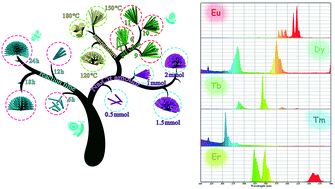Emerging La2O2CN2 matrix with controllable 3D morphology for photoluminescence applications†
Abstract
La2O2CN2 and La2O2CN2:RE3+ (RE = Eu, Dy, Tb, Tm, and Yb/Er) complexes with special morphologies, having uniform rod-like, umbrella-like, cauliflower-like and mushroom-like microarchitectures, have been successfully synthesized by combining a simple hydrothermal route with cyanamidation technology. X-ray diffraction (XRD), scanning electron microscopy (SEM), energy-dispersive X-ray spectra (EDX), and photoluminescence (PL) spectra were used to characterize the samples. The morphology regulation of the products was realized via simply adjusting a series of experimental parameters, including sodium citrate amount, reaction temperature and pH value of the initial solution; the growth mechanisms have been proposed. Under ultraviolet light excitation, the as-obtained La2O2CN2:RE3+ (RE = Eu, Dy, Tb, Tm) products successfully exhibit downconversion emissions showing different fluorescence colors based on the characterized transitions of different rare earth ions. Additionally, upon 980 nm laser excitation, La2O2CN2:Yb/Er phosphors have strong upconversion emissions. La2O2CN2 microstructures are therefore excellent matrixes, and the as-synthesized La2O2CN2:RE3+ samples have potential applications in fluorescent lamps, field emission displays, biological labeling and catalysis.



 Please wait while we load your content...
Please wait while we load your content...